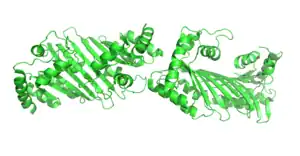APOBEC
APOBEC ("apolipoprotein B mRNA editing enzyme, catalytic polypeptide") is a family of evolutionarily conserved cytidine deaminases.

| APOBEC-like N-terminal domain | |||||||||
|---|---|---|---|---|---|---|---|---|---|
| Identifiers | |||||||||
| Symbol | APOBEC_N | ||||||||
| Pfam | PF08210 | ||||||||
| InterPro | IPR013158 | ||||||||
| |||||||||
| APOBEC-like C-terminal domain | |||||||||
|---|---|---|---|---|---|---|---|---|---|
| Identifiers | |||||||||
| Symbol | APOBEC_C | ||||||||
| Pfam | PF05240 | ||||||||
| InterPro | IPR007904 | ||||||||
| |||||||||
A mechanism of generating protein diversity is mRNA editing. Members of this family are C-to-U editing enzymes. The N-terminal domain of APOBEC like proteins is the catalytic domain, while the C-terminal domain is a pseudocatalytic domain. More specifically, the catalytic domain is a zinc dependent cytidine deaminase domain and is essential for cytidine deamination. RNA editing by APOBEC-1 requires homodimerisation and this complex interacts with RNA binding proteins to form the editosome.[2]
In humans/mammals they help protect from viral infections.[3][4] These enzymes, when misregulated, are a major source of mutation in numerous cancer types.[3][4][5]
A 2013 review discussed the structural and biophysical aspects of APOBEC3 family enzymes.[6] Many of the APOBEC protein features are described in the widely studied APOBEC3G's page.
Family members
Human genes encoding members of the APOBEC protein family include:
References
- PDB: 2NYT; Prochnow, C.; Bransteitter, R.; Klein, M.G.; Goodman, M.F.; Chen, X.S.; functional implications for the deaminase AID. (2007). "The APOBEC-2 crystal structure". Nature. 445 (7126): 447–451. doi:10.1038/nature05492. PMID 17187054. S2CID 4394772.; rendered using PyMOL.
- Wedekind JE, Dance GS, Sowden MP, Smith HC (April 2003). "Messenger RNA editing in mammals: new members of the APOBEC family seeking roles in the family business". Trends Genet. 19 (4): 207–16. doi:10.1016/S0168-9525(03)00054-4. PMID 12683974.
- "Unexpected DNA-Binding Mechanism Suggests Ways to Block Enzyme Activity in Cancer". Dec 2016.
Based on ("Structural Basis for Targeted DNA Cytosine Deamination and Mutagenesis by APOBEC3A and APOBEC3B") online in Nature Structural and Molecular Biology.
- Cervantes-Gracia K, Gramalla-Schmitz A, Weischedel J, Chahwan R (2021). "APOBECs orchestrate genomic and epigenomic editing across health and disease". Trends Genet. 37 (11): 1028–1043. doi:10.1016/j.tig.2021.07.003. PMID 34353635. S2CID 236934922.
- Butler, Kelly; Banday, A. Rouf (28 March 2023). "APOBEC3-mediated mutagenesis in cancer: causes, clinical significance and therapeutic potential". Journal of Hematology & Oncology. 16 (1): 31. doi:10.1186/s13045-023-01425-5. PMC 10044795.
- Jaguva Vasudevan, AA; Smits SH; Höppner A; Häussinger D; Koenig BW; Münk C. (June 2013). "Structural features of antiviral DNA cytidine deaminases" (PDF). Biol. Chem. 394 (11): 1357–1370. doi:10.1515/hsz-2013-0165. PMID 23787464. S2CID 4151961.